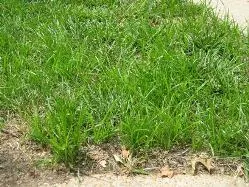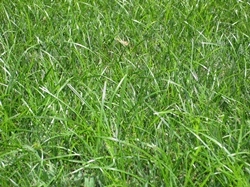Controlling Nutsedge
- Bill DiMercurio

- Jun 11, 2012
- 6 min read
In the St. Louis area, as well as around the world, a species of weed known as nutsedge (Cyperus) is actually listed as one of the world’s worst weed problems, not just in turf and landscape, but on those acres where crops are produced. Here in the Midwest, where our soil actually freezes in the winter, the problem species is yellow nutsedge (Cyperus esculentus). Nutsedge has a distinctive shiny, lime green or neon green color.
It has proven to be very, very difficult to control, in both turf and landscape settings. There is a second, and even tougher, more aggressive species in the south, called purple nutsedge (Cyperus rotundus), which looks virtually identical. Purple nutsedge doesn’t grow where the soils freeze consistently, but it can be found in the Bootheal of Missouri.
While you may not know this weed by the name of “nutsedge” you might call it by a few of its other common names, such as “nutgrass”, “water grass” and even “inch-a-day.” Those are just the names we can print! Yellow nutsedge is a prolific perennial weed, and it is capable of producing tons (Literally, tons!) of underground tubers, which look like miniature potatoes, typically the size of a moist pea here in our neck of the woods. In addition to the true botanical tuber (the “nut”), nutsedge can reproduce and spread by additional types of vegetative tissues, especially rhizomes and stolons. The seeds are fertile, but believe it or not, they’re really not that important in the spread of this troublesome weed.
The lesson in botany really doesn’t matter…it just makes nutsedge one of the toughest weeds of all to control. It’s actually better to use herbicides to control this weed than it is to pull it. Here’s why…when you pull this plant, you’re leaving behind tiny pieces of roots, tubers, rhizomes and stolons, all of which will regenerate an even thicker patch of sedge. The tuber of this nasty weed is in essence nothing more than a giant seed and it can come up from deep within the soil.
Without a doubt, the best herbicide for control of nutsedge in turf is halosulfuron, sold as the ProSedge®. You’ll do a far better job of killing the underground tissues by using halosulfuron, because the active ingredient rapidly moves downward from the leaves into the root system, where it will destroy a great deal of the underground biomass (Buy ProSedge Now). Incidentally, glyphosate, the active ingredient in Roundup® brand herbicides, is only an “average” herbicide for control of yellow nutsedge, and it’s not as effective as halosulfuron. The real beauty of halosulfuron is its safety to turfgrass species. As long as you use it according to label directions, and as long as you don’t apply it when your turf is under significant stress (especially temperatures above 92oF), you shouldn’t cause any injury to your turfgrass.
Spray this weed! Don’t pull it! And sorry to break the news to you, but you should plan on spraying at least twice through the summer. Heavy infestations may even take three applications each season. A hot and moist summer will cause worse infestations of nutsedge than a cool summer. Effective control should start when the weeds start to become a visible weed in turf, which is typically in June, when the daily temperatures get hot. If we have a quick start to the summer heat, the nutsedge will pop earlier, too. If you give nutsedge even a few weeks of respite, it will quickly establish an entirely new set of underground tubers and rhizomes. This weed will come back every year, so just be sure not to let your guard down. If you do a good job it will become thinner and less invasive each year. Nutsedge likes full sun, wet soils, and hot temperatures. When our cool season turf gets stressed from heat (generally anything above 95oF) it quits growing. But nutsedge can grow in temperatures well above 100oF. This is when it is most obvious…turf isn’t growing… yet the sedge is very happy.
We carry a second product, Ortho® Nutsedge Killer, which is a nice product for spot spraying small patches. We’re nagging on you here, folks…don’t let those patches grow unmolested! The Ortho product is a 24 oz “ready to use” spray bottle. ProSedge needs to be mixed in 1 to 2 gallons of water, for spraying 1,000 to 2,000 sq ft of turf.
Nutsedge detests shade, even the little bit of shade and competition created by a vigorous sward. The very best defense against nutsedge is a good offense from a luxurious stand of turf. If your turf has suffered from either disease or insect damage, or both, you’ll have noticed how rapidly the nutsedge filled in those weak areas. Many customers wonder where the nutsedge comes from in the first place, and ofttimes they think it’s in the turf seed! Not! Nutsedge tubers usually always come in topsoil, and even old mulch. It will indeed encroach from your neighbor’s “pasture” so be sure to shame him/her if they don’t keep their weeds within their borders!
Here are a couple of fun facts about nutsedge:
Yellow nutsedge is actually an edible food source.
In tropical climates it’s called “chufa”, but the tubers are larger (marble sized) than they are here in St. Louis (pea-sized).
If you like water chestnuts, you’re eating tubers from the sedge family.
The best defense against nutsedge is a thick, healthy turf, so follow the advice offered below by THE Turf Plan® to combine cultural control techniques along with your herbicide program.
Control of Nutsedge with ProSedge® using a Hand-Can, Pump-Up or Small Sprayer
Open the box of ProSedge®, then the foil package holding the active ingredient
The sachet is “water-soluble,” meaning that it will dissolve in water, too. Add sachet to warm/hot water for best results. Be sure to fill the sprayer to the 2 gallon mark, if your intent is to spray 1,000 to 2,000 sq ft of turf.
For best results add a package of Kalo® DRI nonionic surfactant to the tank, and stir. Be sure the material is dissolved before you start spraying.
This spray solution (2 gallons) containing ProSedge® can cover between 1,000 and 2,000 sq ft of infested turf. This means that you need to avoid “soaking” the nutsedge patches – one pass with the spray wand, or a maximum of two passes over the patch should be sufficient. Do not spray to wet! While ProSedge® has excellent turf safety, an over-application can cause turf injury!
Other Tips for Using ProSedge®
Do not contact the foliage of desirable plants, but if you do, it’s not as unforgiving as glyphosate products. If you do accidentally make contact with foliage of ornamental plants, wash with fresh water, as quickly as possible.
If you’re very careful, you can “dribble” the spray solution into the whorl of the nutsedge plants that are scattered in your landscape beds. The whorl of nutsedge actually has a small “reservoir” and a few strategically placed drops are marvelously effective.
It’s best to spray nutsedge ~2 days after mowing, when it’s easy to detect amongst the turfgrass. Wait at least one day before mowing or watering after application. We like to spray in the evening when the neon-green coloration is easier to detect.
Death is slow. Nutsedge won’t die completely for 21 to 25 days, but it won’t regrow after the first mowing following application. If you notice regrowth 3 to 7 days after spraying, it’s most likely that you missed that patch, or sprayed too lightly.
This product does not kill any other significant lawn and garden weeds, so you needn’t waste time spraying them. You can spray ProSedge® along with any broadleaf product, too.
If you have left over liquid, kill the nutsedge in your neighborhood. This product will not last very long once mixed. Maybe 2 to 3 days, but certainly no longer than that.
Control of Nutsedge with ProSedge® using Hose-End Sprayer
Open the box of ProSedge®, then the foil envelope to get access to the sachet of water-soluble packaging containing the granules.
Drop the water-soluble sachet into the sprayer, and be sure to use hot water. Be sure to fill the sprayer to the 2 gallon mark, if your intent is to spray 1,000 to 2,000 sq ft. It’s OK to use a higher spray volume when using a hose-end sprayer (say 3 gallons).
After you’re sure the granules and water-soluble bag have dissolved, add a package of Kalo DRI™ nonionic surfactant, and stir. A good surfactant helps increase the effectiveness of halosulfuron on nutsedge.
This spray solution can cover between 1,000 and 2,000 sq ft of infested turf. As you’re moving about your lawn, dragging your hose behind you, be sure to keep the spray solution in the sprayer agitated. A wife is usually very effective at helping you achieve the necessary state of “agitation.”
Do not soak the nutsedge patches – make only one pass, or a maximum of two passes, with the sprayer pattern over each patch of nutsedge.
If you have left over liquid, kill the nutsedge in your neighborhood. This product will not last very long once mixed. Maybe 2 to 3 days, but certainly no longer than that.
(Note: This blog was originally published on June 11, 2012)







Comments